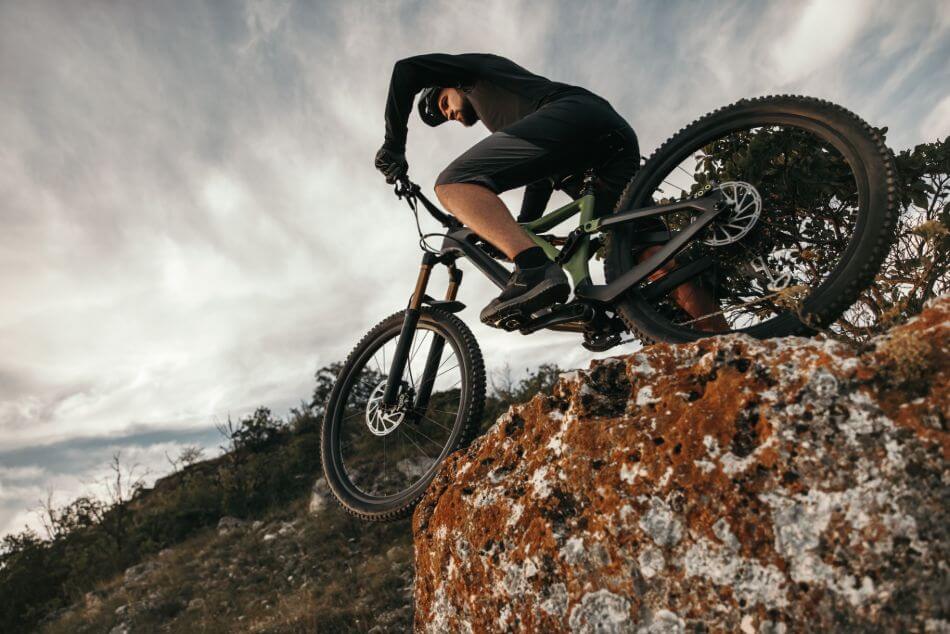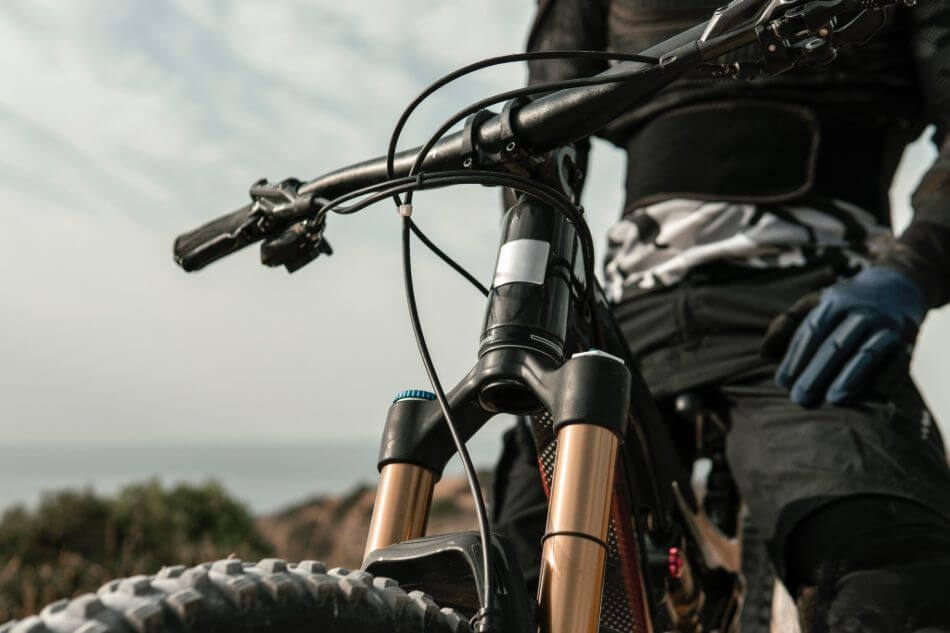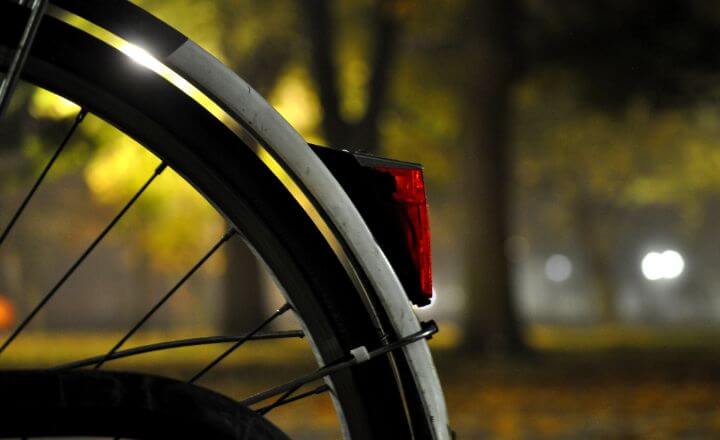(Last updated on February 9th, 2023)

Believe it or not, all the way up until the 1970s, if a cyclist wanted to take a bike down a mountainside, they basically had one option. The trusty ol’ road bike.
In the ’70s, though, manufacturers and cyclists opened up a literal world of options by modifying heavy cruiser road bikes with more high-tech lightweight materials.
From the first bikes of the 1800s to the mountain bikes of the 1970s to now, innovation has been the name of the game in the cycling world.
Today, road bikes and mountain bikes are machines that may sometimes look similar, but from there are designed to perform very separate purpose-built tasks.
Check out our guide about the best bike brands.
Road Bike vs Mountain Bikes: The Differences
In general, all cycling can be broken down into the categories of exercise, adventure, or commuting.
Road bikes cover em all. They’re lightweight, smooth-riding, and usually designed to go far fast. Throw a leg over a road bike, and you’ll sink into a geometry built for speed.
Mountain bikes lean into the exercise and adventure category. Mountain bikes are designed for off-road performance and durability.
They come with a geo, more durable features, and components that make them great in the rough stuff but slow as sloths on the road.
Road Bike Breakdown
Road bikes are any cycle designed to push the pedal to the metal, specifically on paved surfaces.
Highlights: lightweight, higher gearing designed to go far, smaller lighter chainring, over the bar geometry (increases power), thinner rims and wheels, smaller diameter handlebars designed for longer “bent” rides, easy to maintain components, poor off-road performance.
Performance and Purpose
Although road bikes are all designed to ride on pavement or similar hard-packed surfaces, there are a ton of subcategories intended to give each rider a more perfect, fine-tuned experience.
Road bike makes include: your standard sportive or endurance bikes, commuter bikes, touring bikes, road race bikes, Aero bikes, gravel bikes, triathlon bikes, and hybrid bikes.

From there, though, these bikes vary greatly. They’ll all have slightly different geometry, frame material, components, and setups specific to their purpose.
General Components and Setup
Components
- High 2x or 3x gear ratio for long, fast rides
- Focus on lightweight over durability
- Smaller rear cassette for long, fast rides
Cockpit
- Tight Cockpit (bars, seat pedals) for snappy performance
- Use of flat bars, bull bars, drop bars with over the bar geometry designed for speed and power
- Flat, clipless, or cage pedals
- Generally fixed position seat
Wheels and Tires
- Thin (700cc standard) wheels
- Tubed tires for max PSI and low rolling resistance
- Low tread for fast-rolling resistance
Frame
- Steel, carbon, aluminum, titanium frame materials
- Over the bar geometry
Brakes
- Often equipped with rim brakes
- Gravel or hybrid bikes may have disc brakes
Suspension/Forks
- Often “rigid” over suspended riding
- Lightweight air forks when applicable
- A few newer models offering full-suspension road bikes
Downsides of road bikes
- Durability can be an issue when used for the wrong discipline.
- Some cycles will be designed for gravel or hard pack but have a generally limited surface selection.
- Generally higher gear ratio means they won’t always love slow cruising speeds.
- The riding position can place stress on the back, knees, wrists, and neck.
- Often lacks extra suspension due to weight and performance restrictions.
- A common use of rim brakes over more effective but heavy disc brakes
Mountain Bike Breakdown
Mountain bikes aren’t just for mountains anymore! But, wait, were they ever just for mountains?
Mountain” bikes are any cycle designed to be ridden off-road.
Highlights: Durable frame build, lower gearing ratio selection than a road bike, large durable chainring and cranks, durable components, wide handlebars and open Cockpit, wide tires, and wheels, often full or partial suspension, disc brakes, heavier than road bikes, slow on the road.

Performance and Purpose
Like road bikes, there are subcategories of mountain bikes designed to give riders the perfect fit and fine-tuned performance.
Mountain bike makes include: Cross Country bikes, cyclocross bikes, all-mountain or trail bikes, enduro bikes, free ride bikes, downhill bikes, hybrid bikes, and jump bikes.
Unlike road bikes, because the purpose of mountain bikes varies much more widely, so do the bike designs and builds.
For example, a cross country mountain bike or a cyclocross bike may look much closer to a more common road or gravel bike. There are even hybrid versions of road and mountain bikes that can do it all.
A freeride bike, however, or a gravity-oriented downhill bike will be an entirely different machine. These bikes as different from modern road bikes as they come and side by side can be like comparing a Prius to a Peterbilt.
General Components and Setup
Components
- Lower gear ratio for slower, more technical rides
- Often 1x up front with a larger rear cassette
- Durability first focus
Cockpit
- Wide-open Cockpit for stability and maneuverability
- Wide flat or riser bars
- Flat or clipless pedals
- Dropper post common to get the seat out of the way on technical climbs and fast descents

Wheels and Tires
- Wide Wheels (26 in,27.5 in, or 29 inches)
- Generally low psi in tubeless tires for increased grip
- Deep treaded tires for grip
Frame
- Steel, carbon, aluminum, or titanium frame
- Heavy aluminum frame more common for downhill durability
- Relaxed geometry for a wide variety of riding stances and styles
Brakes
- Disc brakes across the board for increased stopping power and predictable wet weather riding
Suspension/Forks
- Durable Full Suspension or front suspension is standard
- Coil or air suspension available in front and rear
Downsides of Mountain Bikes
- Durable construction means heavy ride.
- A massive increase in the effort needed to ride on the road over “road” bike
- Slower on flats and uphills due to geo, components, and rolling resistance
- Suspension creates a less power-efficient ride.
- Added complicated components and heavy abuse may increase maintenance load.
- Necessary durable components lead to a more expensive point of entry.
- More gear required for proper safe use
Which Should You Choose?
At the end of the day, the choice is yours.
Just remember, all road bikes are designed for the pavement and will perform best on that surface. They come with things like lighter, thinner tires for grip and speed and a more aggressive geometry built for power.
And mountain bikes aren’t just for mountains. They cover a broad category of bikes that are all meant to be ridden off-road. So when you’re riding down a gravel road and see a side trail you want to explore, a mountain bike will get you to the bottom or top of it. It does that by relying on rugged durability and features like disc brakes and an expansive cockpit for a more safe, relaxed ride.
If you’re really having trouble deciding, consider the ol’ N+1 principle. It’s worked for me (just don’t tell my wife) so far.
You May Also Like:
Frequently Asked Questions
In my opinion, nope. The narrow, high-pressure tires and rigid frame of a road bike transfer a ton of road feel to the rider. Mountain bikes have large squishy tires, a comfortable seat and riding position, and a large, durable suspension to absorb bumps. Just keep in mind all that cushion will require a bit more pushing.
You bet. Road bikes won’t be as comfortable or last as long off-road, but hitting a trail every now and then should be no problem. Some “road” rides, like gravel bikes, are actually designed for a bit of off-roading. Still, have doubts? Check this out.
This is a yes and no for me, dawg. If you value comfort over tired legs, or your ride to work is on a trail, then go for it. Unfortunately, the things that make mountain bikes great for trails also make them heavy and cumbersome on the road.
Ultimately losing weight will depend on calories in and out. Biking fits into that equation by burning calories. In my opinion(and I’m no doctor), mountain biking burns more of those. Mountain bikes are heavy and require work and constant input from the rider on the uphills and downhills. At the end of the day, though, time in the saddle is probably your best bet. Whichever type of riding you enjoy more, you’ll do more, so stick with that one.

Jeffrey Brown is a writer, editor, and professional bike mechanic with over 7 years of experience working in full-service and community-based bike shops. As a bicycle educator, he has supported youth programs across the US that teach bike mechanics and life skills to prepare the next generation of cyclists.
Jeffrey began his professional mechanic career at his university bike co-op, so he recognizes the grassroots power of the cycling community. Initially self-trained as a mechanic, his subsequent positions as manager and lead educator gave him official training. He has won various awards and grants for his role as a bicycle and environmental advocate.




